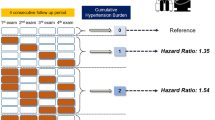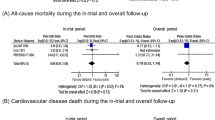Abstract
The Losartan Intervention for Endpoint reduction in hypertension (LIFE) study was designed to compare losartan- vs atenolol-based antihypertensive treatment on cardiovascular morbidity and mortality in a population of 9193 hypertensive patients with left ventricular hypertrophy (LVH). In LIFE, the losartan-based treatment further reduced the primary composite end point (cardiovascular death, myocardial infarction, or stroke) by 13% (risk reduction (RR) 0.87, 95% confidence interval (CI) 0.77–0.98, P=0.021). The further reduction in stroke with losartan (RR 0.75, 95% CI 0.63–0.89, P=0.001) was the major contributing factor to the reduction in the primary end point. Our objective was to project the reduction in stroke observed with a losartan- vs an atenolol-based antihypertensive treatment regimen in the LIFE study to the European Union (EU) population. The number of stroke events averted was estimated by identifying the number of persons in the EU expected to meet the LIFE inclusion criteria, and multiplying this figure by the cumulative incidence risk difference in stroke from LIFE at 5.5 years. The age- and gender-specific prevalence of hypertension, electrocardiographically (ECG)-diagnosed LVH among those with hypertension (inclusion criteria), and heart failure among those with LVH and hypertension (exclusion criteria) were applied to the EU census estimates. We conservatively projected that an estimated 7.8 million individuals aged 55–80 years in the EU are affected by hypertension and ECG-diagnosed LVH. Use of a losartan-based antihypertensive treatment in this population is projected to prevent approximately 125 000 first strokes over a 5.5-year period. A population-wide prevention strategy of using losartan in patients with LVH and hypertension has the potential to have a major public health impact by reducing the morbidity and mortality of stroke in the EU.
This is a preview of subscription content, access via your institution
Access options
Subscribe to this journal
Receive 12 digital issues and online access to articles
$119.00 per year
only $9.92 per issue
Buy this article
- Purchase on Springer Link
- Instant access to full article PDF
Prices may be subject to local taxes which are calculated during checkout



Similar content being viewed by others
References
Murray CJL, Lopez AD . Global mortality, disability, and the contribution of risk factors: Global Burden of Disease Study. Lancet 1997; 349: 1436–1442.
Murray CJL, Lopez AD . Mortality by cause for eight regions of the world: Global Burden of Disease Study. Lancet 1997; 349: 1269–1276.
Wolf PA, D'Agostino RB, Belanger AJ, Kannel WB . Probability of stroke: a risk profile from the Framingham study. Stroke 1991; 22: 312–318.
American Heart Association. Heart Disease and Stroke Statistics—2003 Update. American Heart Association: Dallas, TX.
Evers SM, Engel GL, Ament AJ . Cost of stroke in the Netherlands from a societal perspective. Stroke 1997; 28: 1375–1381.
Isard PA, Forbes JF . The cost of stroke to the National Health service in Scotland. Cerebrovasc Dis 1992; 2: 47–50.
van Exel J, Koopmanschap MA, Reimer WJM, van Wijngaarden JDH . Costs of stroke and stroke services: determinants of patient costs and a comparison of costs of regular care and care organised in stroke services. Cost Eff Resour Alloc 2003; 26: 2.
Youman P, Wilson K, Harraf F, Kalra L . The economic burden of stroke in the United Kingdom. Pharmacoeconomics 2003; 21 (Suppl 1): 43–50.
Spieler JF, Lanoe JL, Amarenco P . Socioeconomic aspects of postacute care for patients with brain infarction in France. Cerebrovasc Dis 2000; 13: 132–141.
Bergman L, van der Meulen JH, Limburg M, Habbema JD . Costs of medical care after first-ever stroke in The Netherlands. Stroke 1995; 26: 1830–1836.
Claesson L et al. Resource utilization and costs of stroke unit care integrated in a care continuum: a 1-year controlled, prospective, randomized study in elderly patients: the Goteborg 70+ Stroke Study. Stroke 2000; 31: 2569–2577.
Caro JJ, Huybrechts KF . Stroke treatment economic model (STEM): predicting long-term costs from functional status. Stroke 1999; 30: 2574–2579.
International Database (IDB). US Census Bureau. Accessed from http://www.census.gov/ipc/www/idbnew.html.
Dahlöf B et al. The Losartan Intervention For Endpoint reduction (LIFE) in Hypertension study: rationale, design, and methods. The LIFE Study Group. Am J Hypertens 1997; 10: 705–713.
Dahlöf B et al. Cardiovascular morbidity and mortality in the Losartan Intervention for Endpoint reduction in hypertension study (LIFE): a randomised trial against atenolol. Lancet 2002; 359: 995–1003.
Coope J, Warrender TS . Randomised trial of treatment of hypertension in elderly patients in primary care. BMJ 1986; 293: 1145–1151.
Medical Research Council Working Party. MRC trial of treatment of mild hypertension: Principal results. BMJ 1985; 291: 97–104.
Medical Research Council Working Party. Medical Research Council trial of treatment of hypertension in older adults: principal results. BMJ 1992; 304: 405–412.
Dahlöf B et al. Morbidity and mortality in the Swedish Trial in Old Patients (STOP-Hypertension). Lancet 1991; 338: 1281–1285.
Primatesta P, Brookes M, Poulter NR . Improved hypertension management and control: results from the health survey for England 1998. Hypertension 2001; 38: 827–832.
Kastarinen MJ et al. Trends in blood pressure levels and control of hypertension in Finland from 1982 to 1997. J Hypertens 1998; 16: 1379–1387.
Marques-Vidal P et al. Sex differences in awareness and control of hypertension in France. J Hypertens 1997; 15: 1205–1210.
Thamm M . Blood pressure in Germany—current status and trends. Gesundheitswesen 1999; 61 Spec No: S90–S93.
Giampaoli S et al. Socioeconomic aspects and cardiovascular risk factors: experience at the Cardiovascular Epidemiologic Observatory. Ital Heart J 2001; 2 (3 Suppl): 294–302.
Banegas JR et al. Blood pressure in Spain: distribution, awareness, control, and benefits of a reduction in average pressure. Hypertension 1998; 32: 998–1002.
Stegmayr B et al. Stroke around the Baltic Sea: incidence, case fatality and population risk factors in Denmark, Finland, Sweden and Lithuania. Cerebrovasc Dis 2003; 6: 80–88.
van Rossum CT et al. Prevalence, treatment, and control of hypertension by sociodemographic factors among the Dutch elderly. Hypertension 2000; 35: 814–821.
Wolf-Maier K et al. Hypertension prevalence and blood pressure levels in 6 European countries, Canada, and the United States. JAMA 2003; 289: 2363–2369.
Martinez MA et al. Prevalence of left ventricular hypertrophy in patients with mild hypertension in primary care: impact of echocardiography on cardiovascular risk stratification. Am J Hypertens 2003; 16: 556–563.
Verdecchia P et al. Prognostic value of a new electrocardiographic method for diagnosis of left ventricular hypertrophy in essential hypertension. J Am Coll Cardiol 1998; 31: 383–390.
US Department of Health and Human Services (DHHS). National Center for Health Statistics. Third National Health and Nutrition Examination Survey, 1988–1994. NHANES III Electrocardiography Data File (Series 11, No. 2A). Centers for Disease Control and Prevention: Hyattsville, MD, 1998.
US Department of Health and Human Services (DHHS). National Center for Health Statistics. Third National Health and Nutrition Examination Survey, 1988–1994. NHANES III Household Adult Data (Series 11, No. 1A). Centers for Disease Control and Prevention: Hyattsville, MD, 1996.
Kalbfleish JD, Prentice RL . The Statistical Analysis of Failure Time Data. Wiley: New York, 1980.
Devereux RB et al. Echocardiographic detection of pressure-overload left ventricular hypertrophy: effect of criteria and patient population. J Clin Hypertens 1987; 3: 66–78.
Jennings G et al. Effects of exercise and other nonpharmacological measures on blood pressure and cardiac hypertrophy. J Cardiovasc Pharmacol 1991; 17 (Suppl 2): S70–S74.
Liebson PR et al. Comparison of five antihypertensive monotherapies and placebo for change in left ventricular mass in patients receiving nutritional-hygienic therapy in the Treatment of Mild Hypertension Study (TOMHS). Circulation 1995; 91: 698–706.
Coca A et al. The impact of different echocardiographic diagnostic criteria on the prevalence of left ventricular hypertrophy in essential hypertension: the VITAE study. Ventriculo Izquierdo Tension Arterial Espana. J Hypertens 1999; 17: 1471–1480.
Hammond IW et al. The prevalence and correlates of echocardiographic left ventricular hypertrophy among employed patients with uncomplicated hypertension. J Am Coll Cardiol 1986; 7: 639–650.
Tingleff J et al. Prevalence of left ventricular hypertrophy in a hypertensive population. Eur Heart J 1996; 17: 143–149.
Laufer E, Jennings GL, Korner PI, Dewar E . Prevalence of cardiac structural and functional abnormalities in untreated primary hypertension. Hypertension 1989; 13: 151–162.
Acknowledgements
We would like to acknowledge Richard L Cooper, MD for providing hypertension prevalence estimates.
Author information
Authors and Affiliations
Corresponding author
Rights and permissions
About this article
Cite this article
Dahlöf, B., Burke, T., Krobot, K. et al. Population impact of losartan use on stroke in the European Union (EU): Projections from the Losartan Intervention For Endpoint reduction in hypertension (LIFE) study. J Hum Hypertens 18, 367–373 (2004). https://doi.org/10.1038/sj.jhh.1001710
Published:
Issue Date:
DOI: https://doi.org/10.1038/sj.jhh.1001710
Keywords
This article is cited by
-
Clusters of metabolic risk factors predict cardiovascular events in hypertension with target-organ damage: the LIFE study
Journal of Human Hypertension (2007)
-
Externe Kontrolle der Medizin
Der Internist (2007)
-
Cost-effectiveness of losartan-based therapy in patients with hypertension and left ventricular hypertrophy: a UK-based economic evaluation of the Losartan Intervention For Endpoint reduction in hypertension (LIFE) study
Journal of Human Hypertension (2006)
-
Possible pathophysiologic mechanisms supporting the superior stroke protection of angiotensin receptor blockers compared to angiotensin-converting enzyme inhibitors: clinical and experimental evidence
Journal of Human Hypertension (2005)
-
Do angiotensin II antagonists provide benefits beyond blood pressure reduction?
Advances in Therapy (2005)



